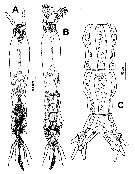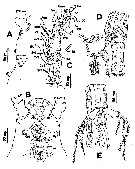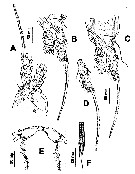|
|
 |
|
Monstrilloida ( Order ) |
|
|
|
Monstrillidae ( Family ) |
|
|
|
Cymbasoma ( Genus ) |
|
|
| |
Cymbasoma cocoense Suarez-Morales & Morales-Ramirez, 2009 (F) | |
| | | | | | | Ref.: | | | Suarez-Morales & Morales-Ramirez, 2009 (p.1259, figs.F); Suarez-Morales, 2011 (p.3, fig.F) |  issued from : E. Suarez-Morales & A. Morales-Ramirez inJ. Nat. Hist., 2009, 43 (21-22); [p.1259, Fig.1].
Female (from Isla del Coco, Costa Rica): A-B, habitus (ventral and dorsal, respectively), showing length of ovirous spines; C, urosome including 5th pedigerous, genital double, anal somites and caudal rami (dorsal).
|
 issued from : E. Suarez-Morales & A. Morales-Ramirez inJ. Nat. Hist., 2009, 43 (21-22); [p.1260, Fig.2].
Female: A, ornamentation of anterior ventral surface of cephalic area between bases of antennules and oral papillae (lateral); B, same (ventral); C, A1 showing armature (following nomenclature of Grygier & Ohtsuka, 1995), dorsal view; D, 5th pedigerous and genital double somites (lateral); E, same (ventral) showing insertion of ovigerous spines.
|
 issued from : E. Suarez-Morales & A. Morales-Ramirez inJ. Nat. Hist., 2009, 43 (21-22); [p.1261, Fig.3].
Female: A, left P1 (posterior; B, right P2 (anterior); C, right P3 (anterior); D, exopod of P4 (anterior); E, P5 (ventral viewl); F, tips of ovigerous spines.
Most setae cut short.
|
 issued from : E. Suarez-Morales & A. Morales-Ramirez inJ. Nat. Hist., 2009, 43 (21-22); [p.1262, Table 1].
Female: armature of swimming legs.
Roman numerals = spines; Arabic numerals = setae.
| | | | | NZ: | 1 | | |
|
Distribution map of Cymbasoma cocoense by geographical zones
|
| | | | Loc: | | | NE Pacif. (Chatham Bay, Isla del Coco, Costa Rica) | | | | N: | 1 | | | | Lg.: | | | (1030) F: 1,45-1,67; {F: 1,45-1,67} | | | | Rem.: | For Suarez-Morales & Morales-Ramirez (2009, p.1269) the occurrence of this species is probably endemic, because the extensive and deep oceanic area between the island and the mainland (532 km off the coast of Costa Rica) was expected to constitute an important impediment for dispersal. The dispersive capacity of the adult and larval monstriloids is limited by the presence of their benthic hosts (polychaetes or molluscs), and their relatively short residence time in the water column.
Cf Table 2 from Lian & Tan (2019) in C. cheni. | | | Last update : 16/07/2019 | |
|
|
 Any use of this site for a publication will be mentioned with the following reference : Any use of this site for a publication will be mentioned with the following reference :
Razouls C., Desreumaux N., Kouwenberg J. and de Bovée F., 2005-2026. - Biodiversity of Marine Planktonic Copepods (morphology, geographical distribution and biological data). Sorbonne University, CNRS. Available at http://copepodes.obs-banyuls.fr/en [Accessed January 07, 2026] © copyright 2005-2026 Sorbonne University, CNRS
|
|
 |
 |






